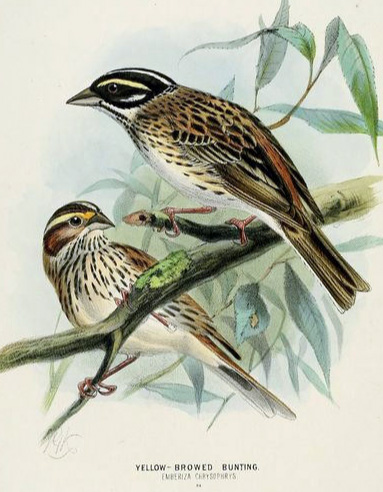Yellow-browed Bunting
Emberiza chrysophrys
| Length: 5.5 inches | Wingspan: 8 inches | Seasonality: Non-resident in South Dakota |
| ID Keys: Strong head pattern, yellow-stripe supercilium fading to white in the rear, white below with streaks on breast and flanks | ||
 The
Yellow-browed Bunting was unknown in North America until a single bird was
found on St. Lawrence Island, off the coast of Alaska, in 2007. Their
normal range is in Asia, where they breed in Siberia and winter in China.
The
Yellow-browed Bunting was unknown in North America until a single bird was
found on St. Lawrence Island, off the coast of Alaska, in 2007. Their
normal range is in Asia, where they breed in Siberia and winter in China.
Habitat: Found in taiga forests of Siberia during the breeding season. Inhabits forested areas with undergrowth and thickets during the winter. They can be found in dense, unbroken forest but forest clearings and edges are more preferable habitat.
Diet: Feeds mostly on seeds, but during the breeding season they consume insects and feed insects to the young.
Behavior: Gregarious outside of the breeding season, where they often form mixed flocks with other Emberiza species.
Nesting: The nest of a Yellow-browed Bunting is usually placed in a small pine or spruce tree, relatively close to the ground (3 to 10 feet). The nest is loose collection of grasses, lined with finer grasses, moss, and animal hair. The female lays 3-6 eggs, and both parents help to incubate them.
Song: The song of a Yellow-browed Bunting is a series of phrases with distinct characteristics, with the first phrase a clear, musical, drawn-out note, followed by two higher-pitched notes, and ending with a variable repetitive series of notes.
Migration: Migratory, with breeding range concentrated in eastern Siberia, and wintering range in China.
Interactive eBird map: Click here to access an interactive eBird map of Yellow-browed Bunting sightings
Similar Species: Reed Bunting, a species not normally found in North America.
Conservation Status: Populations of Yellow-browed Bunting are considered stable and they are found across a wide area in the normal range. The IUCN considers the Yellow-browed Bunting a species of "Least Concern".
Further Information: 1) BirdLife International - Yellow-browed Bunting
2) AviBirds - Yellow-browed Bunting
Photo Information: Public Domain image
| Click below for a higher-resolution map |
|
|
| South Dakota Status: Non-resident in South Dakota |
Additional Yellow-browed Bunting Photos (coming soon!!)
